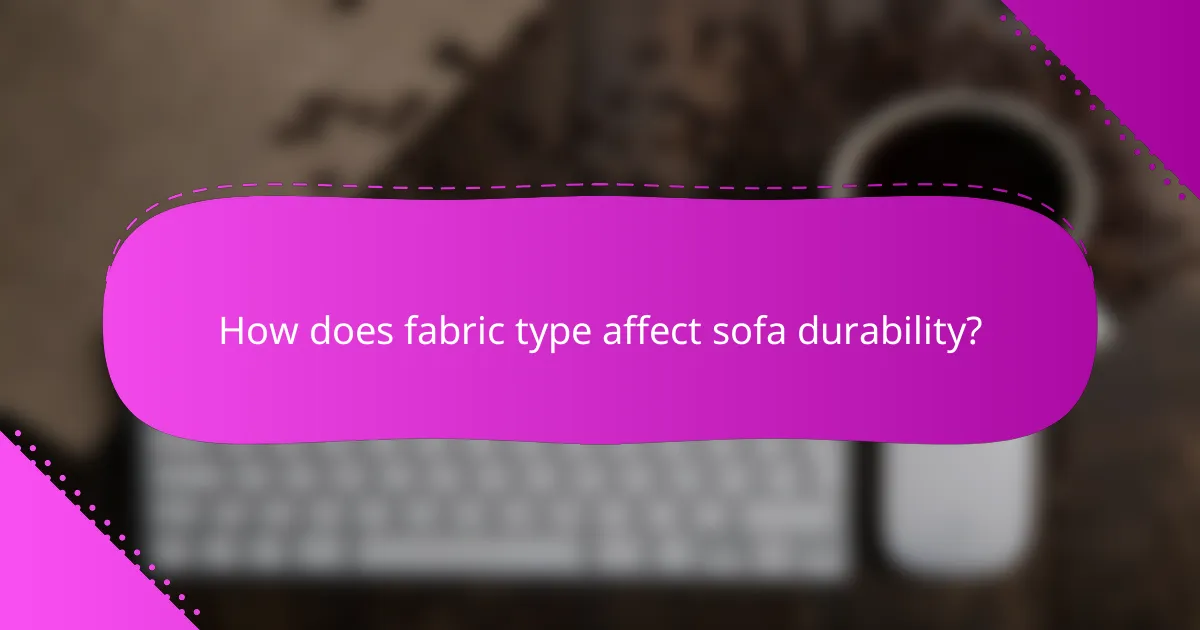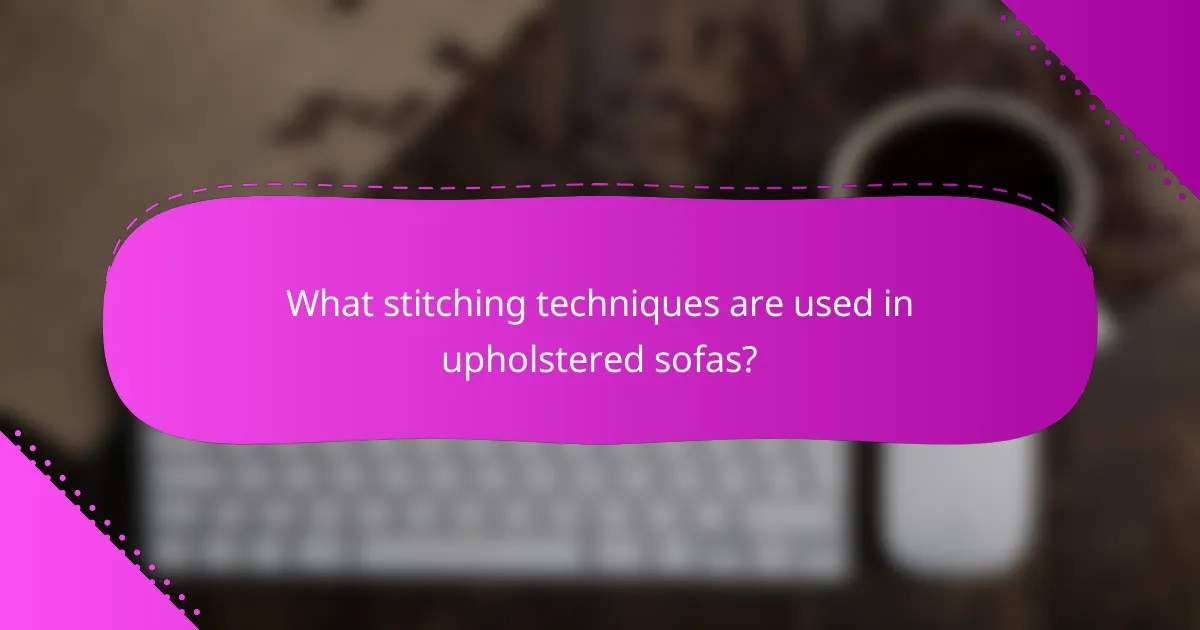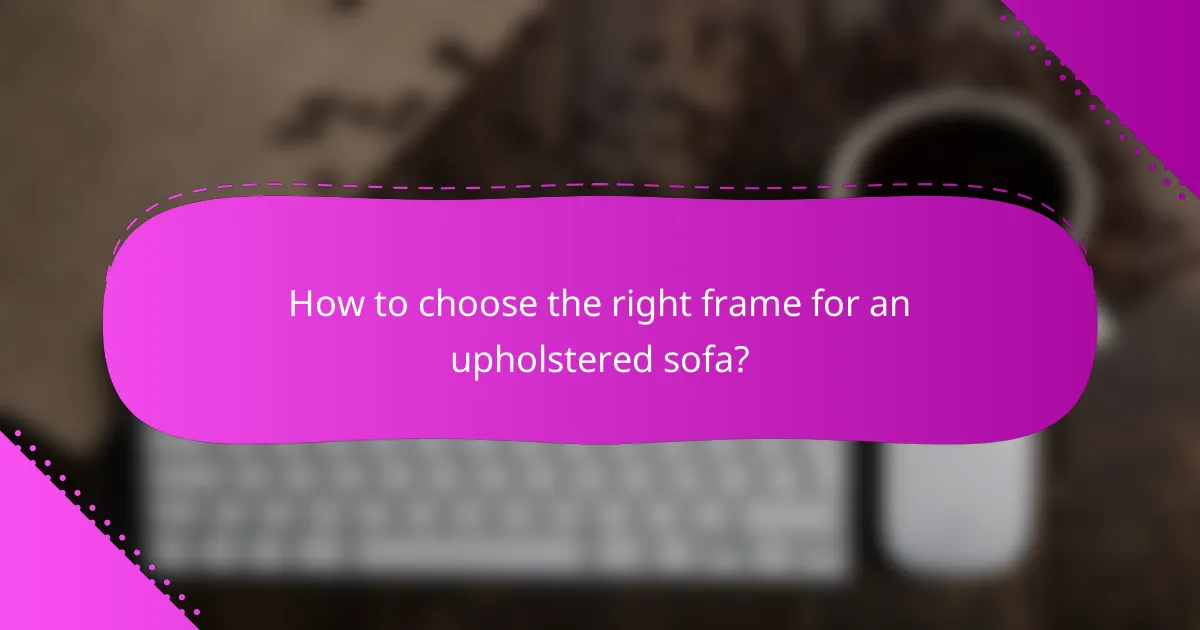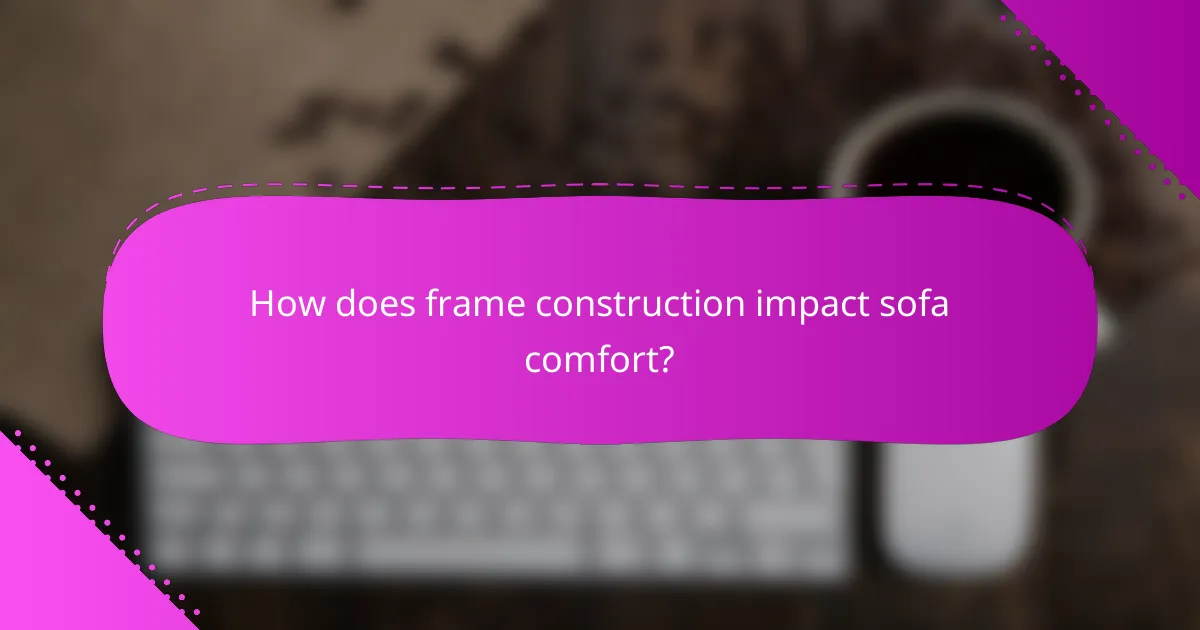When selecting an upholstered sofa, the choice of fabric is paramount, as it affects durability, comfort, and maintenance. High-quality materials can significantly extend the lifespan of your sofa, while various stitching techniques, such as topstitching and double stitching, enhance both durability and aesthetics. Understanding these elements is essential for making an informed decision that meets your needs and style preferences.

What types of upholstery fabrics are available for sofas?
There are several upholstery fabrics available for sofas, each offering unique characteristics and benefits. The choice of fabric can impact durability, comfort, and maintenance, making it essential to understand the options available.
Leather upholstery
Leather upholstery is known for its durability and classic appeal. It is easy to clean and can last for many years with proper care, making it a popular choice for high-traffic areas.
However, leather can be more expensive than other fabrics and may require conditioning to prevent cracking. Consider opting for top-grain leather for a balance of quality and cost.
Microfiber upholstery
Microfiber upholstery is a synthetic fabric that mimics the feel of suede while being highly resistant to stains and spills. Its soft texture makes it comfortable, and it is often more affordable than leather.
This fabric is ideal for families with children or pets, as it can withstand wear and tear. Regular vacuuming and occasional spot cleaning will help maintain its appearance.
Velvet upholstery
Velvet upholstery offers a luxurious look and feel, making it a popular choice for formal living spaces. It is soft to the touch and can add a touch of elegance to any sofa.
However, velvet can be prone to crushing and may require more maintenance to keep it looking its best. Consider using a fabric protector to help resist stains and wear.
Linen upholstery
Linen upholstery is a natural fabric known for its breathability and light texture. It provides a casual, relaxed look, making it suitable for various interior styles.
While linen is comfortable, it can wrinkle easily and may not be as durable as synthetic options. Regular cleaning and careful handling can help prolong its life.
Polyester upholstery
Polyester upholstery is a versatile synthetic fabric that is often blended with other materials for enhanced durability and comfort. It is resistant to fading and easy to clean, making it a practical choice for everyday use.
This fabric can mimic the appearance of more expensive materials while being budget-friendly. Look for high-quality polyester blends for the best performance and longevity.

How does fabric type affect sofa durability?
The type of fabric used on a sofa significantly influences its durability and lifespan. High-quality materials can withstand wear and tear better than lower-quality options, making them a crucial consideration for long-term use.
Leather durability
Leather is known for its exceptional durability and resistance to wear. It can last for many years, often improving in appearance with age as it develops a natural patina. However, it requires regular maintenance to prevent drying and cracking.
When choosing leather, consider the grade; full-grain leather is the most durable, while bonded leather is less expensive but also less resilient. Regular conditioning can help maintain its appearance and longevity.
Microfiber durability
Microfiber is a synthetic fabric that offers a good balance of durability and comfort. It is resistant to stains and easy to clean, making it a popular choice for families and pet owners. With proper care, microfiber sofas can last several years without significant wear.
However, microfiber can be prone to pilling and may fade in direct sunlight. Regular vacuuming and occasional professional cleaning can help maintain its look and feel over time.
Velvet durability
Velvet is a luxurious fabric that can add elegance to any sofa, but its durability varies based on the fiber content. Synthetic velvet tends to be more durable and stain-resistant than natural fibers like silk. While it can withstand moderate use, it may show wear more quickly than leather or microfiber.
To extend the life of a velvet sofa, avoid placing it in high-traffic areas and use a soft brush to remove dust and debris. Regular cleaning according to the manufacturer’s instructions is essential to maintain its appearance.

What stitching techniques are used in upholstered sofas?
Upholstered sofas utilize various stitching techniques to enhance durability, aesthetics, and comfort. Common methods include topstitching, double stitching, and French seams, each offering unique benefits and applications.
Topstitching
Topstitching involves sewing a visible stitch along the edges of the fabric, creating a decorative and functional finish. This technique not only reinforces seams but also adds a stylish detail that can complement the sofa’s design. It’s commonly used in both contemporary and traditional styles.
When considering topstitching, look for even spacing and consistent thread color to ensure a polished appearance. This technique is particularly effective for thicker fabrics, as it helps maintain shape and structure.
Double stitching
Double stitching consists of sewing two parallel lines of stitches along the seam, providing extra strength and preventing fabric from fraying. This method is ideal for high-use areas, as it enhances durability and longevity of the upholstery.
For optimal results, ensure that the thread used is strong and compatible with the fabric type. Double stitching is often found in sofas designed for heavy wear, such as those in family rooms or commercial settings.
French seams
French seams encase the raw edges of the fabric within the seam, creating a clean and finished look. This technique is particularly useful for lightweight or delicate fabrics, as it prevents fraying and adds a refined touch to the upholstery.
When choosing French seams, consider the fabric’s weight and drape. This method is best suited for sofas that prioritize aesthetics, such as those in formal living spaces, where a neat finish is essential.

How to choose the right frame for an upholstered sofa?
Choosing the right frame for an upholstered sofa is crucial for durability and comfort. A well-constructed frame supports the sofa’s structure and affects its longevity and overall feel.
Wood frame options
Wood frames are popular for their strength and aesthetic appeal. Hardwoods like oak, maple, and beech offer durability, while softwoods like pine are lighter and more affordable but may not last as long.
When selecting a wood frame, look for solid wood rather than particleboard or plywood, as solid wood typically provides better support. Check for joints that are glued and screwed rather than just stapled for enhanced stability.
Metal frame options
Metal frames are known for their strength and modern look. They are often made from steel or aluminum, providing a sturdy base that resists warping and bending over time.
Consider metal frames if you prefer a sleek design or if weight is a concern. They can be heavier than wood frames, but their longevity and resistance to pests make them a solid choice for many households.
Particleboard frame options
Particleboard frames are typically the most budget-friendly option, made from compressed wood particles and adhesives. While they are lighter and cheaper, they may not offer the same level of durability as solid wood or metal frames.
When choosing a particleboard frame, ensure it has a sturdy construction and consider the overall weight capacity. These frames are best suited for occasional use or lighter upholstery, as they may not withstand heavy wear over time.

What are the benefits of a solid wood frame?
A solid wood frame provides durability, stability, and support for upholstered sofas, making it a preferred choice for long-lasting furniture. Unlike particleboard or metal frames, solid wood frames resist warping and can withstand regular use over time.
Longevity
Solid wood frames are known for their longevity, often lasting several decades with proper care. The natural strength of hardwoods like oak, maple, or cherry ensures that the frame can endure daily wear and tear without significant damage.
To maximize the lifespan of a solid wood frame, avoid exposing it to extreme temperatures or humidity, which can cause the wood to expand or contract. Regular maintenance, such as polishing and checking for loose joints, can also enhance durability.
Stability
The stability of a solid wood frame is crucial for maintaining the shape and comfort of an upholstered sofa. A well-constructed wooden frame provides a sturdy foundation that prevents sagging and shifting over time.
When selecting a sofa, look for frames made from hardwoods with reinforced joints, such as dowels or corner blocks, to ensure added stability. This construction helps the sofa maintain its original form, even with heavy usage.
Weight capacity
Solid wood frames typically offer a higher weight capacity compared to other materials, making them suitable for various body types and usage scenarios. A well-built wooden frame can support several hundred kilograms without compromising its integrity.
When shopping for an upholstered sofa, inquire about the weight capacity of the frame and consider the number of users it will accommodate. This ensures that the sofa remains functional and safe for all users, reducing the risk of damage over time.

How does frame construction impact sofa comfort?
The frame construction of a sofa significantly influences its overall comfort and durability. A well-built frame provides essential support, ensuring that the sofa maintains its shape and comfort over time.
Types of frame materials
Sofa frames can be made from various materials, including hardwood, softwood, and metal. Hardwood frames, such as those made from oak or maple, are typically the most durable and provide excellent support. Softwood frames, like pine, are lighter and more affordable but may not last as long. Metal frames offer a modern aesthetic and can be very sturdy, but they may not provide the same warmth as wooden options.
Construction techniques
The construction technique used in a sofa frame can affect its stability and longevity. Dovetail joints and mortise-and-tenon joints are considered high-quality methods that enhance strength. In contrast, stapled or glued joints are often weaker and may lead to frame failure over time. Look for frames that are reinforced with corner blocks for added durability.
Impact on comfort and longevity
A sturdy frame directly contributes to the comfort of a sofa by providing consistent support. Sofas with weak frames may sag or creak, leading to discomfort. Additionally, a well-constructed frame can extend the life of the sofa, making it a better investment in the long run. When shopping, consider testing the sofa by sitting on it to assess its support and comfort level.
